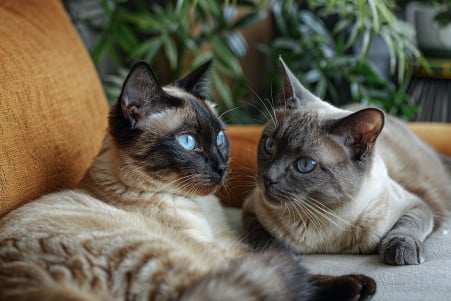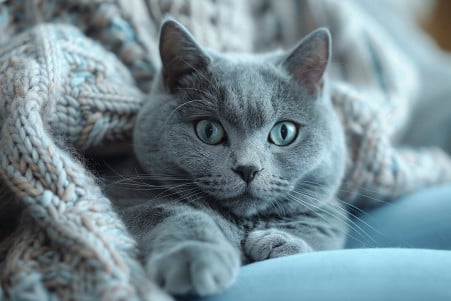Why Do Stray Cats Rub Against Your Legs? Exploring Feline Pheromones & Behavior
17 March 2024 • Updated 15 March 2024

Stray cats are known to be social with humans, but what makes them want to rub up against us? Stray cats rub against people’s legs to mark them with pheromones, creating a familiar scent profile for comfort and territory. This is a sign of trust and love, and it shows that cats consider humans to be part of their social group.
In this article, we will take a deep dive into the world of animal behaviorism and feline ethology to understand the many factors that go into a stray cat’s decision to rub up against you.
From the chemical signals of pheromones to the complex nature of feline social behavior, we will look at a number of scientific papers and expert opinions. By the end, you will have a better understanding of the many layers that go into this behavior and a greater respect for the detailed ways that stray cats interact with the human world.
Why do stray cats rub against your legs?
Pheromones and How Cats Communicate
Pheromones are an important part of how cats communicate, and they act as a kind of invisible chemical language that cats use to communicate with one another.
According to Beaphar, pheromones are odorless and are detected by a cat’s vomeronasal organ, which can elicit instinctual responses.
Cats use pheromones to mark their territory and create a space that feels safe and familiar. When cats rub their faces on objects, or in the case of stray cats, human legs, they release Feline Facial Pheromones (FFP). These pheromones are known to create a sense of well-being and happiness, which helps cats feel more secure and indicates to the cat that the object they’re marking, including humans, is part of their territory.
In addition, FELIWAY notes that there are different pheromones that send different messages, which can impact behaviors like seeking comfort and marking territory.
When stray cats mark humans with these pheromones, they’re not only comforting themselves, but they’re also creating a nonverbal relationship with us.
This has a deep impact on both the cat, who may feel more secure, and the human, who becomes a part of the cat’s social group. Knowing this, we can understand the chemical messages that stray cats are sending to certain people, which can help us understand the trust and comfort that they’re expressing and open the door to a deeper understanding of their social behavior.
Understanding the Social Lives of Stray Cats in Cities
The social lives of stray cats in urban areas share some similarities with those of pet cats, but there are also some key differences. As a study in PMC notes, free-ranging cats are facultatively social, which means that their social behavior can range from being solitary to living in groups and is often dictated by the availability of food and human contact.
While pet cats can live in multi-generational groups, stray cats are more likely to form colonies, although these groups are less structured and more likely to form around a food source.
One of the biggest factors that influences how stray cats interact with humans is the environment. The availability of food and the density of the cat population in a given area can determine how likely a cat is to approach a human.
For example, a cat is more likely to rub against a person’s legs if they’ve learned that this behavior is likely to result in a positive outcome, such as food or attention. As the Merck Veterinary Manual explains, a cat’s behavior is heavily influenced by its hunting behavior and socialization.
A cat’s early experiences with humans can determine how friendly and social it is as an adult.
In addition, a cat may decide to interact with a person based on their past experiences with them or their ability to read that person’s body language and determine that they are not a threat.
These complex behaviors demonstrate the adaptability and complexity of stray cats’ social lives, and they also suggest that there is much more to learn about the psychological factors that drive these animals to seek out and form relationships with humans.
The Psychology Behind Why Feral Cats Like People
The psychological factors that lead feral cats to seek out human contact are many and varied. According to a study in Scientific Reports, the welfare and response of animals during human-animal interactions is significantly affected by the individual behaviors and characteristics of the people involved.
Therefore, how feral cats perceive human contact may be influenced by their early experiences with humans. For example, a feral cat may have learned behaviors that encourage future interactions, like the common leg-rubbing behavior, from positive interactions with humans.
Meanwhile, research highlighted by the American Psychological Association notes that, like dogs, cats can form secure attachments to their human caregivers. However, feral cats form these attachments through consistent and positive interactions, which means that they trust and like humans because of the experiences they have with them over time, not because of an immediate bond.
The result is that feral cats’ past experiences and early socialization play a big role in how they decide whether to approach or avoid humans as they move through their environments. In the world of feral cats, trust and affection are earned through repeated positive interactions with caring and empathetic people. These psychological factors lay the groundwork for future evolutionary studies into the mutually beneficial bond between people and their pet cats.
The Evolutionary History of the Cat–Human Relationship
From wild hunters to domesticated pets, cats have undergone a remarkable transformation that has made them an important part of human evolution. As Scientific American explains, all domestic cats can be traced back to a single wild ancestor, Felis silvestris, that was first domesticated about 9,500 years ago in the Near East.
Cats have likely benefited from a number of evolutionary advantages as a result of their association with humans, including adapting to the human environment, learning to live with and communicate with people, and developing affiliative behaviors like leg rubbing.
These affiliative behaviors may have helped stray cats survive by enabling them to secure territories with access to food and other resources and by forming alliances with humans.
As Psychology Today notes, the relationship between cats and humans has evolved over thousands of years, with cats learning to communicate with people and adapt to their presence.
As a result, stray cats may have inherited the evolutionary benefits of their domesticated ancestors’ relationship with humans, which means that they may seek out human contact not just because it provides immediate rewards like food but also because it reflects deeply ingrained evolutionary behaviors that have historically benefited their species.
The result is a relationship between humans and cats that is the product of a long history of evolution and one that continues to influence the behavior of stray cats today. When they rub against our legs, these solitary animals are reminding us of a history that has led both humans and cats to adapt in ways that ensure they can benefit from each other’s presence.
Navigating Encounters: How to Approach Stray Cats
When a stray cat rubs against your legs, it is a sign of trust and an invitation to interact. Business Insider notes that the cat is marking you as part of their territory and asking for attention or resources.
To respond in a way that is helpful, you can gently extend your hand and let the cat sniff it, which gives the cat a chance to get used to your scent. If the cat seems open to it, you can pet it gently, ideally on the head or back.
That said, it’s important to be cautious. Union Lake Veterinary Hospital notes that some cats may be more likely to approach people who are calm or who use certain body language. Always make sure to respect the cat’s space and back off if the cat seems uncomfortable. Positive reinforcement of a stray cat’s behavior can help build social bonds, while negative reinforcement can help the cat understand its boundaries.
Part of making sure that the interaction is safe for everyone involved is making sure that you are looking out for the cat’s well-being and the potential health risks to people. Alley Cat Allies suggests that you first assess the situation to see if the cat seems healthy or if it looks like it needs medical attention.
By doing this, you can make sure that you are setting yourself and the cat up for a positive interaction and a positive relationship in our shared environments.
Wrapping Up: Stray Cats and Their Behavior
When a stray cat rubs against a human’s legs, they are doing so much more than just marking their territory. They are using pheromones to mark territory and build social bonds in a way that is much more complex than it may seem.
In doing so, they are showing trust, creating a comforting scent profile, and letting other cats know that they are in the area.
The psychological and evolutionary reasons behind these behaviors are a result of the long history of domestication between cats and humans, and the benefits that have come from both species understanding each other’s social needs.
Understanding the importance of these behaviors is important to ensure that humans and stray cats can coexist in a way that is healthy and respectful to both parties. Understanding the evolutionary reasons behind these behaviors can help to remind us of the tenuous relationship that we have with other species.
So, as we come across these animals that are both independent and affectionate, let’s take a moment to recognize the messages that they are sending and the history that we share with them that has led to an unspoken agreement between our species.


